Kultur in Gefahr - ITI
Kultur in Gefahr - ITI
Kultur in Gefahr - ITI
Create successful ePaper yourself
Turn your PDF publications into a flip-book with our unique Google optimized e-Paper software.
6 Artistic Expression <strong>in</strong> a Corporate World<br />
Artistic Expression <strong>in</strong> a Corporate World 7<br />
some forms of artistic expression are more enterta<strong>in</strong><strong>in</strong>g, and others <strong>in</strong>vite<br />
calm reflection, or do both. However, such k<strong>in</strong>ds of dist<strong>in</strong>ctions (and there<br />
are many more to make: a work may, for <strong>in</strong>stance, be more traditional or<br />
more experimental) do not relate to the size of production, distribution and<br />
promotion. Artistic expressions created, produced, distributed, promoted<br />
and received on a mass scale belong to the cultural field of a society as<br />
much as the music, films, books, et cetera, that have a smaller scale.<br />
It is important to be aware that artistic expressions <strong>in</strong> different<br />
cultures present themselves <strong>in</strong> diverse ways; they may have dist<strong>in</strong>ct ways<br />
of presentation, entrepreneurial <strong>in</strong>frastructures, mean<strong>in</strong>gs, f<strong>in</strong>ancial<br />
underp<strong>in</strong>n<strong>in</strong>gs, artistic professions, attentiveness of audiences, and many<br />
other k<strong>in</strong>ds of struggles and contradictions. We should not forget that<br />
artistic fields are often symbolic battlegrounds about, for <strong>in</strong>stance, what<br />
sounds are important and are organised for maximum attention, what<br />
words are terrible and should be suppressed, and what k<strong>in</strong>ds of images are<br />
absolutely powerful and seduce until the magic has been broken. It is a<br />
cont<strong>in</strong>uous hegemonic struggle. But this struggle concerns all artistic<br />
expressions, whether they have been produced, distributed and promoted<br />
on a huge or a small scale. This fight <strong>in</strong>cludes moral, aesthetic, social, legal<br />
and economic aspects.<br />
Although it may be confus<strong>in</strong>g and conflict<strong>in</strong>g, it is exactly this<br />
multitude of artistic expressions that should have the right to exist, with its<br />
own conditions, and they should certa<strong>in</strong>ly not be organised by just a few<br />
enterprises. This multitude differs <strong>in</strong> any society (whether geographically<br />
dest<strong>in</strong>ed or digitally constituted). Of course, artists and their<br />
<strong>in</strong>termediaries should be able to make a liv<strong>in</strong>g, and that is the<br />
entrepreneurial side of their work. However, the social doma<strong>in</strong> that<br />
concerns the freedom of communication should not be taken over<br />
completely by commercial forces.<br />
The second word <strong>in</strong> the concept “cultural diversity” (from a<br />
democratic perspective) concerns not only the much-desired diversity of<br />
artistic expressions (the content) and occasions for cultural<br />
communication. It is just as important that there are many owners of the<br />
means of production and distribution and many decision-makers<br />
concern<strong>in</strong>g the artistic communication. A Convention on Cultural<br />
Diversity would strengthen, one would hope, the national states’<br />
competence to make sure that this can be realised. It is not about<br />
exclud<strong>in</strong>g works of art and enterta<strong>in</strong>ment from the cultural market; it is<br />
about guarantee<strong>in</strong>g that audiences may be confronted with the broad<br />
range of options that exist and, then, make their choice.<br />
Mid October 2003 the General Conference of Unesco unanimously<br />
adopted a resolution mandat<strong>in</strong>g its director-general to develop, <strong>in</strong> two<br />
years time, a prelim<strong>in</strong>ary draft Convention on protect<strong>in</strong>g cultural content<br />
and artistic expression. In chapter 3 we will see that a couple of drafts for<br />
such a Convention exist already, which may speed up the process with<strong>in</strong><br />
Unesco. Nevertheless with<strong>in</strong> this unanimity, the United States (s<strong>in</strong>ce<br />
recently back <strong>in</strong> Unesco; see chapter 1) made clear that, for them, culture is<br />
a product like any other, and therefore a new <strong>in</strong>ternational legally b<strong>in</strong>d<strong>in</strong>g<br />
<strong>in</strong>strument for culture is superfluous and makes no sense. However,<br />
representatives of most other countries spoke passionately and with great<br />
force <strong>in</strong> favour of such a Convention. This may not be surpris<strong>in</strong>g because<br />
people are fight<strong>in</strong>g for their identities. These contradictory viewpo<strong>in</strong>ts<br />
between the US and nearly all the rest of the world will take Unesco, with<strong>in</strong><br />
the next few years, <strong>in</strong>to a decisive battleground on the fundamental<br />
question of whether artistic expression will be a trade only product, or<br />
whether other values will mitigate the huge commercial <strong>in</strong>terests that<br />
narrow diversity and open access to the tools of cultural communication.<br />
World-wide there are quite a lot of people already <strong>in</strong>volved <strong>in</strong> push<strong>in</strong>g the<br />
idea of a Convention on Cultural Diversity and mak<strong>in</strong>g the analytical effort<br />
to formulate what it should look like while try<strong>in</strong>g to solve the numerous<br />
contradictions and near impossibilities that belong to such an immense<br />
project. I had the pleasure of <strong>in</strong>terview<strong>in</strong>g Ivan Bernier, Peter Grant, Garry<br />
Neil, and Yvon Thiec for this book. The International Network for Cultural<br />
Diversity (INCD), a cultural NGO, is, and has been for many years, an<br />
excellent breed<strong>in</strong>g ground for the development of my th<strong>in</strong>k<strong>in</strong>g about arts<br />
<strong>in</strong> the global context. The Research Group Arts and Economics of the<br />
Utrecht School of the Arts is a more than welcome home from where I visit<br />
the world and its arts, and my colleague Giep Hagoort <strong>in</strong> this Research<br />
Group cont<strong>in</strong>ues to <strong>in</strong>spire. Johanna Damm, Lisa Kölker, and Alies<br />
MacLean gave me very welcome logistical and research support.<br />
On 25, 26 and 27 September 2003 I had the opportunity to <strong>in</strong>vite<br />
more than twenty researchers and cultural activists from all parts of the<br />
world to a work<strong>in</strong>g conference Regulations <strong>in</strong> Favour of Cultural<br />
Diversity (which is the basis for chapter 4) <strong>in</strong> the Cultural Centre De Balie<br />
<strong>in</strong> Amsterdam, organized by Eric Kluitenberg and Liedewij Loorbach. The<br />
conference was supported by the Dutch development organization Hivos.



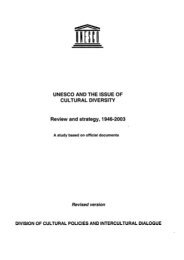
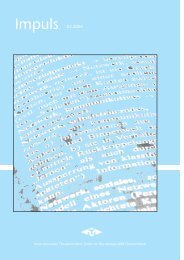
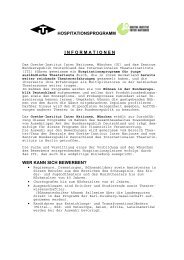
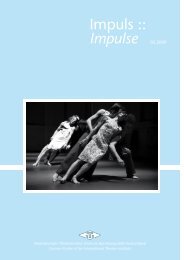
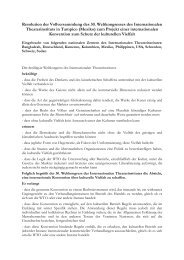
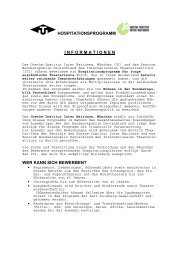
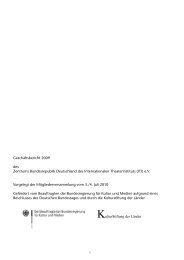
![Geschäftsbericht 2010 [pdf 2 MB] - ITI](https://img.yumpu.com/4380475/1/184x260/geschaftsbericht-2010-pdf-2-mb-iti.jpg?quality=85)